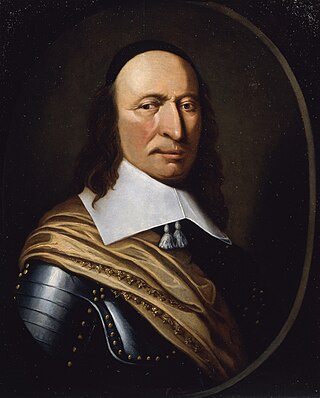
Peter Stuyvesant was a Dutch colonial administrator who served as the director-general of New Netherland from 1647 to 1664, when the colony was provisionally ceded to the Kingdom of England. He was a major figure in the history of New York City and his name has been given to various landmarks and points of interest throughout the city.

New Netherland was a 17th-century colonial province of the Dutch Republic located on the East Coast of what is now the United States. The claimed territories extended from the Delmarva Peninsula to Cape Cod. Settlements were established in what became the states of New York, New Jersey, Delaware, and Connecticut, with small outposts in Pennsylvania and Rhode Island.

Marble Hill is the northernmost neighborhood in the New York City borough of Manhattan. Although once part of Manhattan Island, a large modern shipping canal was dug to its south over a small earlier canal in the late 19th century. The neighborhood was then connected to the mainland United States in the early 20th century. The Bronx surrounds the neighborhood to the west, north, and east, while the Harlem River is its southern border.

Kinderhook is a town in the northern part of Columbia County, New York, United States. The population was 8,330 at the 2020 census, making it the most populous municipality in Columbia County. The name of the town means "Children's Corner" in the language of the original Dutch settlers (Kinderhoek). The name "Kinderhook" has its root in the landing of Henry Hudson in the area around present-day Stuyvesant, where he was greeted by Native Americans with many children. With the Dutch kind meaning "child" and hoek meaning "corner", it could be that the name refers to a bend in the river where the children are. The eighth president of the United States, Martin Van Buren, was born in Kinderhook and retired to it.

Riverdale is a residential neighborhood in the northwestern portion of the New York City borough of the Bronx. Riverdale, which had a population of 47,850 as of the 2000 United States Census, contains the city's northernmost point at the College of Mount Saint Vincent. Riverdale's boundaries are disputed, but it is commonly agreed to be bordered by Yonkers to the north, Van Cortlandt Park and Broadway to the east, the Kingsbridge neighborhood to the southeast, either the Harlem River or the Spuyten Duyvil neighborhood to the south, and the Hudson River to the west. Riverdale Avenue is the primary north–south thoroughfare through Riverdale.
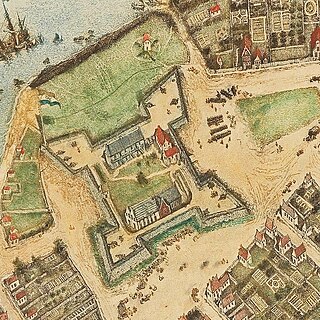
Fort Amsterdam was a fortification on the southern tip of Manhattan Island at the confluence of the Hudson and East rivers. The fort and the island were the center of trade and the administrative headquarters for the Dutch and then British/Colonial rule of the colony of New Netherland and thereafter the Province of New York. The fort was the nucleus of the settlement on the island and greater area, which was named New Amsterdam by the first Dutch settlers and eventually renamed New York by the English, and was central to much of New York's early history.

Spuyten Duyvil Creek is a short tidal estuary in New York City connecting the Hudson River to the Harlem River Ship Canal and then on to the Harlem River. The confluence of the three water bodies separate the island of Manhattan from the Bronx and the rest of the mainland. Once a distinct, turbulent waterway between the Hudson and Harlem rivers, the creek has been subsumed by the modern ship canal.

Spuyten Duyvil is a neighborhood of the Bronx, New York City. It is bounded on the north by Riverdale, on the east by Kingsbridge, on the south by the Harlem River, and on the west by the Hudson River, although some consider it to be the southernmost part of Riverdale.
This is a list of Directors, appointed by the Dutch West India Company, of the 17th century Dutch province of New Netherland in North America. Only the last, Peter Stuyvesant, held the title of Director General. As the colony grew, citizens advisory boards – known as the Twelve Men, Eight Men, and Nine Men – exerted more influence on the director and thus affairs of province.
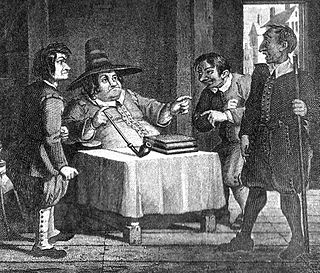
Wouter van Twiller was an employee of the Dutch West India Company and the fourth Director of New Netherland. He governed from 1632 until 1638, succeeding Peter Minuit, who was recalled by the Dutch West India authorities in Amsterdam for unknown reasons.
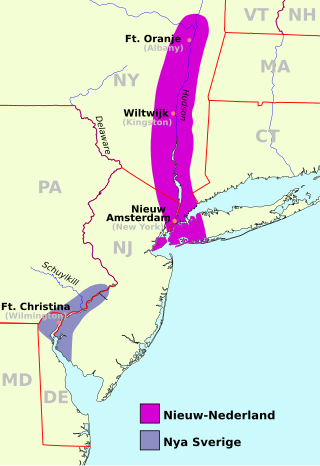
The Peach War, sometimes called the Peach Tree War, was a one-day occupation of New Amsterdam on September 15, 1655, by several hundred Munsee, followed by raids on Staten Island and Pavonia. 40 colonists were killed and over 100, mostly women and children, were taken captive.

Anthony's Nose is a 900+ ft (270 m) peak in the Hudson Highlands along the east bank of the Hudson River in the hamlet of Cortlandt Manor, New York. It lies at the extreme northwest end of Westchester County, and serves as the east anchor of the Bear Mountain Bridge.
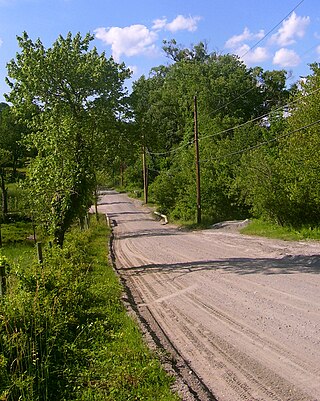
The Albany Post Road was a post road – a road used for mail delivery – in the U.S. state of New York. It connected New York City and Albany along the east side of the Hudson River, a service now performed by U.S. Route 9 (US 9).
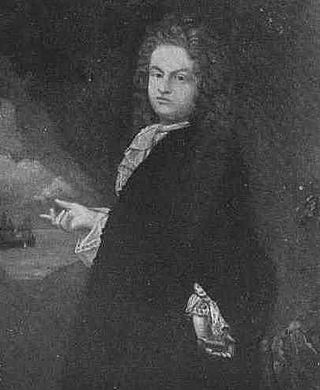
Frederick Philipse, first Lord of the Manor of Philipseborough and patriarch of the Philipse family, was a Dutch immigrant to North America of Bohemian heritage. A merchant, he arrived in America as early as 1653. In 1662, he married Margaret Hardenbrook de Vries, a wealthy and driven widow. Together, and variously in league with slavers, pirates, and other undesirables alongside the prominent and respectable, the couple amassed a fortune.
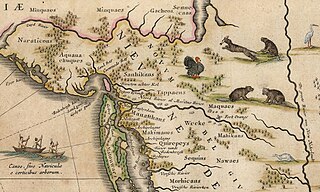
Bergen was a part of the 17th century province of New Netherland, in the area in northeastern New Jersey along the Hudson and Hackensack Rivers that would become contemporary Hudson and Bergen Counties. Though it only officially existed as an independent municipality from 1661, with the founding of a village at Bergen Square, Bergen began as a factory at Communipaw circa 1615 and was first settled in 1630 as Pavonia. These early settlements were along the banks of the North River across from New Amsterdam, under whose jurisdiction they fell.
Communipaw is a neighborhood in Jersey City in Hudson County, in the U.S. state of New Jersey. It is located west of Liberty State Park and east of Bergen Hill, and the site of one of the earliest European settlements in North America. It gives its name to the historic avenue which runs from its eastern end near Liberty State Park Station through the neighborhoods of Bergen-Lafayette and the West Side that then becomes the Lincoln Highway. Communipaw Junction, or simply The Junction, is an intersection where Communipaw, Summit Avenue, Garfield Avenue, and Grand Street meet, and where the toll house for the Bergen Point Plank Road was situated. Communipaw Cove at Upper New York Bay, is part of the 36-acre (150,000 m2) state nature preserve in the park and one of the few remaining tidal salt marshes in the Hudson River estuary.

Jan Evertsz Bout, was an early and prominent Dutch settler in the 17th century colonial province of New Netherland.
Hendrick Hendricksen Kip (1600–1685) was a Dutch colonial magistrate. He was one of the nine original popular assemblymen serving in New Amsterdam from 1647 under Pieter Stuyvesant, Governor of New Netherlands.

Andries Hudde (1608–1663) was a landowner and colonial official of New Netherland.
















